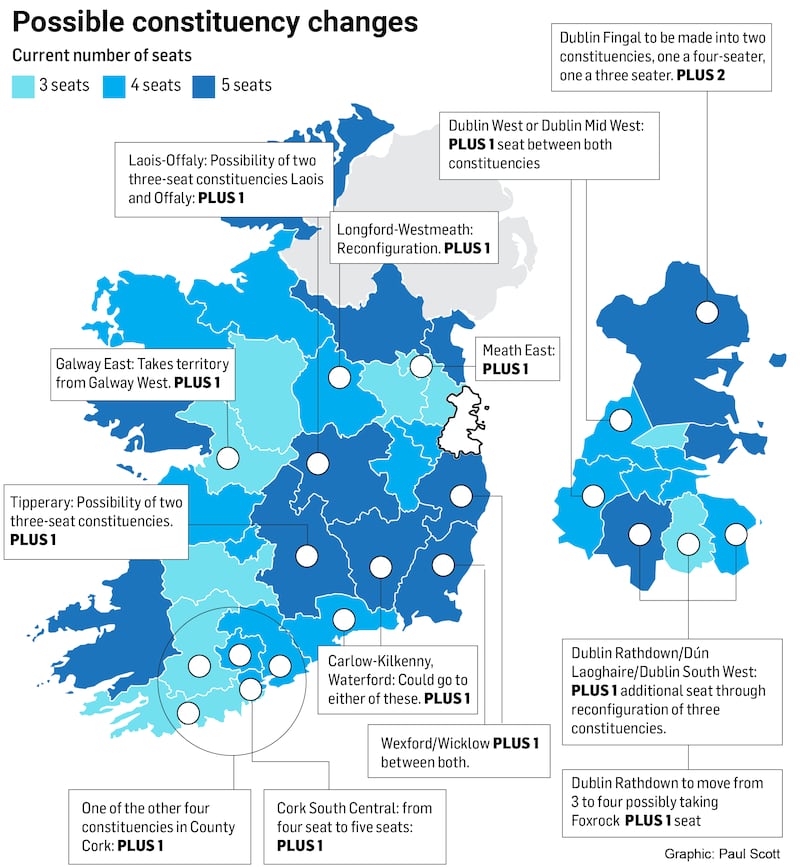Article 16 of the Constitution specifies there must be one TD for between 20,000 and 30,000 of the population.
That provision was drawn up at a time when the population of the State was just less than three million. That meant a Dáil of between 100 and 150 seats. For much of the first century of the State, the ratio stayed closer to the lower 20,000 mark. But as the population has risen dramatically this century the needle has pointed perilously close to the upper limit of one TD per 30,000 people.
The provisional data from Census 2022 show that the population of the State has crept over five million for the first time. At 5,123,536 it is an increase of more than 361,671 from 2016.
Conservative increase?
What it means is that the next Dáil will have the largest number of TDs in the history of the State even if the Electoral Commission opts for the most conservative increase in the range set out by Minister for Local Government Darragh O’Brien.
READ MORE
The commission will determine a Dáil size of between 171 and 181 seats. That is an increase of between 11 and 21 on the current assembly, which is 160.
The commission is only being established this year and the redrawing of constituency boundaries will be its first task. If it were to go for the maximum increase of 21, that would work out at about one TD per 28,350 people. That’s not too far away from the maximum number. It means that even if the next Dáil does not have 181 seats, the Dáil after that is sure to have that number, and then some.

If the State’s population continues its upward trajectory, the size of the Dáil could become an issue in the future with the 200 barrier broken in coming years. Indeed, if we were to adopt the lower limit of 20,000 people per seat set out by the Constitution right now, the Dáil would have 255 seats.
A Constitutional amendment may be needed to increase the ratio between population and public representative. For example, it is one MP per 92,000 people in Westminster.
For now, the newly established commission’s task will be to decide on the number of TDs and then try to accommodate them in constituencies that are evenly balanced in terms of population per TD. An extra layer of complication is they have to respect county boundaries as much as possible. It’s an impossible task to stay within the lines and it’s rare these days for a county to survive intact without ceding territory to (or stealing territory) from another county.

Can Labour ever be relevant again? Ivana Bacik says yes
In the past, there have been some incompatible arrangements. Roscommon (which has only two quotas) has been paired with just about every other county surrounding it, bar Mayo, to make up a constituency. Leitrim was split in half in 2007 to create Roscommon-South Leitrim and Sligo North-Leitrim. It was a very contentious decision and, for a while, deprived the country of having even one TD. The current arrangement for Roscommon has meant Galway East loses a seat in order to create the new Roscommon-Galway constituency. The change was not popular in Galway.
The commission will be acutely aware of county boundaries but the geographic reality is that some constituencies will be ugly ducklings.
Most of the changes will occur in Leinster. The biggest population increases have been in the east. A clear majority of Irish people now live within 15km of the Irish Sea.
Extra seats
So where will the extra seats go in the next Dáil? All but one of the 39 constituencies have more than the limit of 30,000 people per TD so there will be a spread. The sharpest rise in population has been in counties Longford, Meath and Kildare. Some constituencies are now way over the 30,000 limit. In Dublin Fingal, there are now 34,138 people for each TD. In Dublin Rathdown it is 33,718 while in Kildare North it is 33,589.
The commission’s work cannot be second-guessed. It might, for example, decide on a radical redraw and create a host of new constituencies. Public representatives are acutely aware of the population changes and the implications they will have on their present constituencies.
Here is the current state of thinking on constituency changes that might occur, based on numerous conversations with TDs and part officials:
- There are likely to be at least five extra seats in Dublin. Two of them might go to Dublin Fingal, which is a five-seater. That means it would be split into two constituencies, one a four-seater, the other with three seats. That would involve either Howth and Sutton, or Baldoyle, or both, moving from Dublin Bay North;
- There could also be an extra seat for either Dublin Mid-West or Dublin West;
- On the south of the river, two extra seats will be shared between Dún Laoghaire, Dublin Rathdown and Dublin South-West. It could mean that the three-seater Dublin Rathdown gains one, or possibly two seats;
- In Leinster, population growth would mean Kildare North increasing by one seat to five, Meath East increasing to four seats, Longford-Westmeath increasing to five and Laois-Offaly moving from a five-seater to two three-seat constituencies of Laois and Offaly;
- The three five-seater constituencies of Carlow-Kilkenny, Wexford and Wicklow are more problematic. An extra seat will be required. Most TDs believe that either Wicklow or Wexford will become two three-seaters, but will need to take territory from the other county. Waterford could also be due an extra seat but would need to take some electoral areas from other counties;
- Cork South-Central looks certain to increase from four to five seats, while the other four constituencies in Cork will probably accommodate one extra seat between them;
- There has been talk of Tipperary becoming two three-seat constituencies like in the past but that would mean slicing off pieces of Clare or Offaly or even Waterford. Politically, it may be tricky given that both local authorities in the county merged to become one;
- In Connacht, the most likely scenario suggested by most TDs is for Galway East to increase from three seats to four.
If these changes were to happen it would result in an increase in 15 seats in the next Dáil, giving a chamber of 175 seats. The commission has the scope to increase it by a further six seats, if it so wishes.














